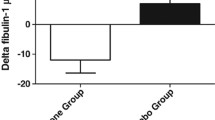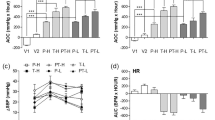Abstract
Background
The VIOS (Vascular Improvement with Olmesartan medoxomil Study) study is a randomized, parallel study to determine the relative effects of suppressing the renin-angiotensin system (RAS) with the angiotensin receptor antagonist olmesartan medoxomil versus suppressing sympathetic drive with the β-adrenoceptor antagonist atenolol on remodeling of the subcutaneous small resistance vessel. Remodeling of small resistance vessels may be the earliest pathologic finding associated with hypertension. It may predate the onset of clinically apparent hypertension.
Methods
In this study, 100 patients with stage I hypertension are characterized at baseline before being treated for 1 year to obtain a goal BP of less than 140/90mm Hg as defined by Joint National Committee (JNC)-7. Resistance vessel remodeling is determined using the gluteal fat biopsy technique in the hypertensive patients and a group of normotensive healthy volunteers. Additionally, efforts will be made to define whether noninvasive hemodynamic parameters, retinal vessel measurement changes, or biologic markers may predict and track the underlying vascular morphologic and physiologic changes induced by either regimen during the 12-month treatment period.
Results
The primary endpoint will be the degree of vascular remodeling as obtained from percutaneous biopsy of gluteal subcutaneous resistance vessels in each of two treatment arms compared with the normal volunteers. The design of the study and the pertinent baseline characteristics of these patients with uncomplicated essential hypertension are presented.
Conclusion
The suppression of the RAS by the blockade of angiotensin II type 1 (AT1) receptors may demonstrate remodeling effects on the ubiquitous small resistance vessels similar to that seen in the myocardium and renal glomeruli, thus affording more complete end-organ protection.






Similar content being viewed by others
References
Schiffrin EL. Reactivity of small blood vessels in hypertension: relation with structural changes. State of the art lecture. Hypertension 1992 Feb; 19(2 Suppl.): II1–9
Li JS, Sharifi AM, Schiffrin EL. Effect of AT1 angiotensin-receptor blockade on structure and function of small arteries in SHR. J Cardiovasc Pharmacol 1997 Jul; 30 (1): 75–83.
Schiffrin EL, Park JB, Intengan HD, et al. Correction of arterial structure and endothelial dysfunction in human essential hypertension by the angiotensin receptor antagonist losartan. Circulation 2000 Apr 11; 101 (14): 1653–9.
Sharifi AM, Li JS, Endemann D, et al. Effects of enalapril and amlodipine on small-artery structure and composition, and on endothelial dysfunction in spontaneously hypertensive rats. J Hypertens 1998 Apr; 16 (4): 457–66.
Thybo NK, Stephens N, Cooper A, et al. Effect of antihypertensive treatment on small arteries of patients with previously untreated essential hypertension. Hypertension 1995 Apr; 25 (4 Pt 1): 474–81
Intengan HD, Deng LY, Li JS, et al. Mechanics and composition of human subcutaneous resistance arteries in essential hypertension. Hypertension 1999 Jan; 33 (1 Pt 2): 569–74
Izzard AS, Rizzoni D, Agabiti-Rosei E, et al. Small artery structure and hypertension: adaptive changes and target organ damage. J Hypertens 2005 Feb; 23 (2): 247–50.
Park JB, Charbonneau F, Schiffrin EL. Correlation of endothelial function in large and small arteries in human essential hypertension. J Hypertens 2001 Mar; 19 (3): 415–20.
Rizzoni D, Porteri E, De Ciuceis C, et al. Effect of treatment with candesartan or enalapril on subcutaneous small artery structure in hypertensive patients with noninsulin-dependent diabetes mellitus. Hypertension 2005 Apr; 45 (4): 659–65.
Chobanian AV, Bakris GL, Black HR, et al. Seventh report of the Joint National Committee on Prevention, Detection, Evaluation, and Treatment of High Blood Pressure. Hypertension 2003; 42(6): 1206–52
Yokoyama H, Averill DB, Brosnihan KB, et al. Role of blood pressure reduction in prevention of cardiac and vascular hypertrophy. Am J Hypertens 2005 Jul; 18 (7): 922–9.
Drazner MH, Thompson B, Rosenberg PB, et al. Comparison of impedance cardiography with invasive hemodynamic measurements in patients with heart failure secondary to ischemic or nonischemic cardiomyopathy. Am J Cardiol 2002 Apr 15; 89 (8): 993–5.
Marik PE, Pendelton JE, Smith R. A comparison of hemodynamic parameters derived from transthoracic electrical bioimpedance with those parameters obtained by thermodilution and ventricular angiography. Crit Care Med 1997 Sep; 25 (9): 1545–50.
Ventura HO, Taler SJ, Strobeck JE. Hypertension as a hemodynamic disease: the role of impedance cardiography in diagnostic, prognostic, and therapeutic decision making. Am J Hypertens 2005 Feb; 18 (2 Pt 2): 26S–43S
Cohn JN, Finkelstein S, McVeigh G, et al. Noninvasive pulse wave analysis for the early detection of vascular disease. Hypertension 1995 Sep; 26 (3): 503–8.
Zimlichman R, Shargorodsky M, Boaz M, et al. Determination of arterial compliance using blood pressure waveform analysis with the CR-2000 system: reliability, repeatability, and establishment of normal values for healthy European population. The seven European sites study (SESS). Am J Hypertens 2005 Jan; 18 (1): 65–71.
O’Rourke MF, Pauca AL. Augmentation of the aortic and central arterial pressure waveform. Blood Press Monit 2004 Aug; 9 (4): 179–85.
Wilkinson IB, Fuchs SA, Jansen IM, et al. Reproducibility of pulse wave velocity and augmentation index measured by pulse wave analysis. J Hypertens 1998 Dec; 16 (12 Pt 2): 2079–84
Bond S, Riley WA, Barnes RW, et al. Validation studies of a noninvasive real time B-scan imaging system. In: Budinger TF, Berson AS, Ringquist I, et al., editors. Noninvasive techniques for assessment of atherosclerosis in peripheral, carotid, and coronary arteries. New York: Raven, 1982: 197–203
Yamashina A, Tomiyama H, Takeda K, et al. Validity, reproducibility, and clinical significance of noninvasive brachial-ankle pulse wave velocity measurement. Hypertens Res 2002 May; 25 (3): 359–64.
Brinchmann-Hansen O, Sandvik L. The width of the light reflex on retinal arteries and veins. Acta Ophthalmol (Copenh) 1986 Aug; 64 (4): 433–8.
Dahlof B, Stenkula S, Hansson L. Hypertensive retinal vascular changes: relationship to left ventricular hypertrophy and arteriolar changes before and after treatment. Blood Press 1992 May; 1 (1): 35–44.
Herrington DM, Brosnihan KB, Pusser BE, et al. Differential effects of E and droloxifene on C-reactive protein and other markers of inflammation in healthy postmenopausal women. J Clin Endocrinol Metab 2001 Sep; 86 (9): 4216–22.
Nakamoto H, Ferrario CM, Fuller SB, et al. Angiotensin-(1–7) and nitric oxide interaction in renovascular hypertension. Hypertension 1995 Apr; 25 (4 Pt 2): 796–802
Senanayake PD, Moriguchi A, Kumagai H, et al. Increased expression of angiotensin peptides in the brain of transgenic hypertensive rats. Peptides 1994; 15(5): 919–26
Pocock SJ, McCormack V, Gueyffier F, et al. A score for predicting risk of death from cardiovascular disease in adults with raised blood pressure, based on individual patient data from randomised controlled trials. BMJ 2001 Jul 14; 323 (7304): 75–81.
Houston MC, Basile J, Bestermann WH, et al. Addressing the global cardiovascular risk of hypertension, dyslipidemia, and insulin resistance in the southeastern United States. Am J Med Sci 2005 Jun; 329 (6): 276–91.
Bianchi S, Bigazzi R, Amoroso A, et al. Silent ischemia is more prevalent among hypertensive patients with microalbuminuria and salt sensitivity. J Hum Hypertens 2003 Jan; 17 (1): 13–20.
Tomura S, Kawada K, Saito K, et al. Prevalence of microalbuminuria and relationship to the risk of cardiovascular disease in the Japanese population. Am J Nephrol 1999; 19(1): 13–20
Tomiyama H, Yamashina A, Arai T, et al. Influences of age and gender on results of noninvasive brachial-ankle pulse wave velocity measurement: a survey of 12517 subjects. Atherosclerosis 2003 Feb; 166 (2): 303–9.
McVeigh GE, Bratteli CW, Morgan DJ, et al. Age-related abnormalities in arterial compliance identified by pressure pulse contour analysis: aging and arterial compliance. Hypertension 1999 Jun; 33 (6): 1392–8.
Acknowledgments
This study was supported by a grant and study medications from Daiichi Sankyo Inc. Dr Smith has received honoraria as a member of the clinical speakers bureau of Daiichi Sankyo. The other authors declare that they have no conflicts of interest relevant to the contents of this study.
Author information
Authors and Affiliations
Corresponding author
Rights and permissions
About this article
Cite this article
Smith, R.D., Yokoyama, H., Averill, D.B. et al. The Protective Effects of Angiotensin II Blockade with Olmesartan Medoxomil on Resistance Vessel Remodeling (The VIOS study). Am J Cardiovasc Drugs 6, 335–342 (2006). https://doi.org/10.2165/00129784-200606050-00006
Published:
Issue Date:
DOI: https://doi.org/10.2165/00129784-200606050-00006




